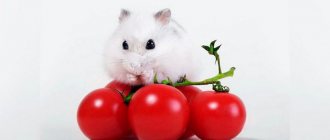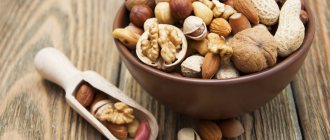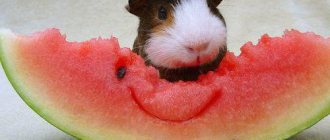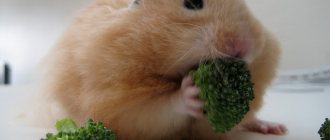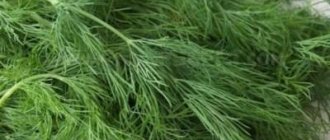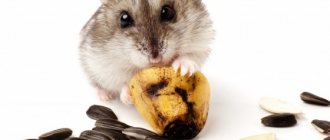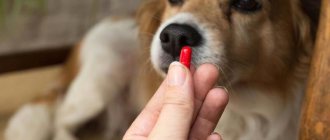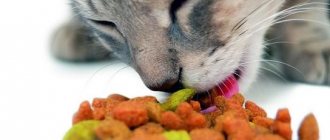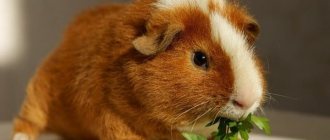The need for cereals for hamsters
When providing a complete diet for rodents, the cereals included in it should be taken into account. Cereals for a hamster are a base that cannot be replaced. Cereals contain many microelements that have a positive effect on the pet’s life expectancy and its general condition. And the protein included in them becomes the basis for gaining muscle mass and determines the activity of the hamster.
Regardless of what kind of cereal you give your animal, it must be included in the diet. Otherwise, you risk depriving your hamster of a large amount of nutrients, which will have negative consequences on its health and immune system.
Pay attention to the quality of cereals that hamsters eat. It is better to buy them from a pet store than from the open market to prevent them from having harmful residue or poison in the form of pesticides, which is often found from private sellers.
The balance of the hamster's cereal intake needs to be controlled; it needs to be fed about twice a day. Follow some rules regarding cereals:
- Heavy cereals (boiled porridge, millet, lentils) should be given to rodents in the first half of the day so that they have time to completely digest them.
- There is no need to repeat typical grains in the diet (bulgur and wheat, oats and oat flakes) to avoid oversaturation with vitamins or lack thereof.
- Combine cereals, alternating them with the base one - wheat; any cereals and cereals can be combined with it.
Make your hamster's diet as varied as possible, however, when introducing new grains into the diet, do it gradually, monitoring the reaction of his body.
Cereals can and should be combined with each other, the beneficial substances contained in wheat complement oatmeal well, and pearl barley goes well with buckwheat. It is also not recommended to take rice and buckwheat at the same time, as the mixture will be heavy for the animal’s intestines.
For one day, a rodent's diet requires 30 grams of a dry mixture consisting of cereals. When cooking porridge, consider the weight of dry cereals.
How to feed a Djungarian hamster
How many times a day should you feed the animal? Djungarians are nocturnal (like other hamsters), so the main meal should be in the evening. You can feed food only once a day, but it wouldn’t be a mistake to feed it twice (in this case, let’s eat 70% of the daily amount in the evening, and 30% in the morning). This is not done for gorging before bed, but so that during the day, when the animal periodically wakes up, it has something to eat - the dwarf has a very fast metabolism (an eternally hungry hamster).
An adult Djungarian hamster only needs a tablespoon of food per day (with a small heap). Even if the food quickly disappears from the bowl, this is not a reason to feed more: most likely, your pet took everything that it didn’t eat into the pantry in order to “hamster” it later. It is his instinct to stock up.
Add more rash or I’ll bite your nose off!
Don't forget to promptly remove leftover perishable foods, otherwise they will begin to rot in the pantry.
Place the bowl itself in the house as far as possible from the toilet (the hamster will determine where he will have a toilet himself, so it will not be possible to designate places for feeding and relief in advance).
Buckwheat raw and boiled
When selecting cereals for hamsters, most often animal owners try to find out whether hamsters can eat buckwheat, since it often becomes the basis of their pets’ diet. It needs to be given to get basic microelements, starting from an early age of the pet.
It helps improve blood circulation and brain function, and is often taken as a medicine for toxic poisoning of an animal.
It can be taken in three forms:
- Raw. A hamster can eat raw buckwheat if it is completely healthy, so it can take in the maximum amount of vitamins contained in the cereal. It is recommended to feed your pets dry buckwheat so that the cereal is better digestible.
- Boiled. This method should be used least often, since the option is not very useful for the animal; it helps to restore strength in case of illness. It is recommended to cook it in water, since milk has a bad effect on the health of rodents.
- Soaked. This method can be compared with the first in terms of the number of beneficial properties; for this, buckwheat is soaked overnight in warm water.
Buckwheat porridge should be introduced into the diet of hamsters, but keep in mind that it should not occupy the main place in it. Combine methods of preparing cereals, feeding him mainly raw and soaked buckwheat, and boiled buckwheat only for illnesses.
First, a few words about rice and its properties
Rice contains virtually no salt, which makes it a healthy food for people suffering from cardiovascular diseases and kidney problems. One serving of rice porridge contains 8 g of protein, 7 g of fat and about 90 g of carbohydrates. One grain of rice contains many useful elements:
- B vitamins, vitamin K, niacin, biotin and vitamin E;
- about 40 different macro- and microelements such as calcium, phosphorus, iron, iodine and other compounds;
- tryptophan, lecithin and plant fiber.
But fiber in rice crops is found in very small quantities. Brown varieties contain an average of 4% of this substance, while white varieties do not reach 3%. The product is very rich in starch, of which rice contains just over 50%.
Different processing methods also affect the beneficial properties of grains. Among the steamed, crushed and polished ones, the last one will be the most valuable. These are the usual white grains that have been polished and steamed, during which all the benefits of the rice shell are given to the grain itself. At the same time, white rice is inferior in valuable properties to its counterparts of coarse varieties - red, brown or black grains.
Rice is a fairly versatile product from which you can prepare porridges and soups, pilaf, flatbreads, salads and sweet desserts. It is important to remember that the variety of dishes is intended primarily for humans; a rodent can only be offered a vegetable salad with cereal, porridge or flatbread with the exception of spices. But it is not recommended to overuse rice with either one or the other, since one serving of the dry product has an average of 350 kcal, depending on the variety.
Oats and oat flakes
Oatmeal is often included by pet owners in their diet. You can give your hamster oats in steamed form, but this should be done if you are sick or with small hamsters. Healthy animals are recommended to eat dry flakes, as they are digested faster and have a positive effect on the pet’s digestion.
Hamsters can eat oats in two forms:
- Oatmeal - rolled oats is best eaten by young hamsters, as it is softer and has a gentler effect on the pet’s digestive system.
- Oatmeal is useful for hamsters, but is not always well digested, especially with low immunity. It is recommended for hamsters to eat it boiled or soaked, as it can damage your pet’s teeth.
You can dilute the diet with sprouted oats; they are quickly absorbed and help improve the quality of teeth and wool.
Can a hamster eat buckwheat and rice?
Since childhood, we have all been familiar with the taste of porridge with buckwheat and rice, and the words “I ate little porridge” are no less familiar. But indeed, porridge is not only an easily digestible product, but also very healthy and necessary.
Buckwheat is famous for its reserves of vitamins B, PP and E, fiber, protein, iodine, iron and phosphorus. This is a very useful product, especially for the younger generation. Can a hamster eat buckwheat and in what form (in the form of cereal or porridge)? This frequently asked question is not difficult to answer.
It would not be amiss to remind you that the basis of the correct diet of any hamster is dry food: grain mixtures. Buckwheat is grown in fields on an industrial scale; local wild hamsters use it with pleasure and benefit. So why not treat your pet rodent to buckwheat?
Buckwheat can be given to without fear in the form of dry cereal . In this form, it is part of the usual diet. However, it is worth noting that it is impossible to completely switch to a buckwheat diet; use the golden rule - what is too much is not healthy. We recommend using high-quality grain mixtures, where all components are proportionally balanced according to the hamster’s need for them. This way, you don’t have to worry about what food and how much to feed your furry pet.
Millet and wheat
Porridges with similar names have different recommendations. Millet is a small, hard grain that is difficult for hamsters to chew and digest, but it also contains many useful microelements. It is recommended to give it occasionally and in small quantities, or completely exclude it from the hamster’s diet.
Wheat is a grain that can be eaten in almost any form. For better absorption, it is recommended to give it in crushed form, sprout it or soak it. Whole wheat is poorly absorbed by the hamster's body. Sprouted wheat can be purchased at a pet store, or sprouted at home. You can start feeding hamsters wheat by introducing it in the form of porridge, which can be cold brewed overnight.
You should only buy sprouted wheat at a pet store to prevent intoxication of the animal, or you can sprout the grain at home.
What do little hamsters eat?
If everything is fine with the mother, the cubs usually do not need additional food. But if for some reason the babies are left without a mother or she refuses to feed them, you will have to feed the babies using a pipette or a painting brush. Buy a special formula for newborns at a pet store and dilute it to the consistency of milk. Newborn babies should be fed every two hours, then gently massage their tummies to improve digestion. Small hamsters need to be provided with a bottle of warm water (not higher than +31 °C).
At the age of two weeks, you can already give baby formula (Gerber, Agusha), thin porridge with water and without sugar, crushed cottage cheese, egg yolks and fresh herbs.
From three weeks you can give pureed “adult” food. As a rule, at this age babies can already eat on their own.
Pregnant and lactating hamsters need more protein foods.
Rice boiled and dry
Rice is a source of many beneficial substances in its natural form. It undergoes processing before entering the store, which is why it loses all its beneficial properties. Because of this, cereals are not of particular value, and it makes no sense to feed the hamster rice.
In addition, regardless of the method of preparing porridge, it is heavy for the animal’s body, and therefore can lead to digestive diseases. Be especially careful when using wild varieties of rice, as they can lead to intoxication of the animal’s body.
But if you have intestinal problems, you can carefully introduce rice porridge into your diet. Most often it is used for diarrhea, or for the successful growth of young individuals. But for this, it is recommended to feed them rice once or twice a week, using one option for preparing porridge - pre-soaking it for 7-10 hours.
But rice can be used in another form; a medicinal decoction can be made from it, which is used instead of water to treat rodents from diarrhea. It effectively helps eliminate the problem while safely affecting the digestive system.
What else can Djungarian hamsters eat?
- Fruits (not exotic, but “local”) - eat no more than a couple of times a week, preferably 1.
- If your dry food does not contain greens, you can add them to the diet (dried).
- Non-starchy vegetables (cucumber, bell pepper) - can be eaten almost every day, alternating.
- Low-starch vegetables (zucchini, carrots, pumpkin) - it is enough to feed them to the dwarf 2 times a week.
- Protein – 1-2 times a week.
- Nuts, seeds - try to give them less often, as a treat (high fat content of the product).
The main emphasis in nutrition is on grains.
What fruits and berries can hamsters eat?
Fruits for the Djungarian hamster should not be too sweet (remember about diabetes!). It is for this reason that you should not feed the dzhungarik exotic foods at all. Occasionally, you can give a dried banana, but not more than once a week (formally, a banana is a berry, but that’s what we’re used to).
Be sure to remove large seeds and pits from the fruit. Many of them can be poisonous to the dwarf. The possibility that such a baby will simply choke on the seeds cannot be ruled out either.
Follow the same recommendations when choosing berries.
Lifehack. Use glycemic index tables for foods. Those with a high indicator should never be fed to the Djungarian hamster.
A few words about dried fruits. These are the same fruits, only the water has been removed from them. The composition remains virtually unchanged; we feed according to the same principles as fresh fruit.
Choose fruits that are as sweet as possible for your pet.
What vegetables can dzungaria eat?
Vegetables have the same problem - they increase the risk of diabetes. Here we are no longer talking about sweets (fructose), but about starch, which “works” in the same way as fructose or sugar - it increases the level of glucose in the blood.
Therefore, try to feed your hamster vegetables that are low in starch and high in fiber.
The less starch in vegetables, the better.
What do hamsters prefer from greens?
For greens, let's eat your usual salad, parsley and dill (1-2 times a week). From “improvised” (more precisely, pasture) plants, you can feed plantains and dandelions. Greens are a storehouse of vitamins, microelements and nutrients for the Djungarian rodent, do not neglect them.
Avoid greens that have a strong smell or taste. Those. any plants that have an imbalance in composition (too many essential oils or acids). That is why it is strictly forbidden to feed the Djungarian hamster with onion sprouts, garlic and sorrel.
Don't forget about greens - very healthy.
Animal protein for the carnivorous dwarf
In its natural environment, the dzhungarik is by no means a vegetarian, and is not averse to sometimes eating what passes by. These are mainly insects. Therefore, for proper nutrition, you need to add protein foods to your hamster’s menu.
Ideal for:
- Boiled egg whites
- Skim cheese
- Boiled white fish
- Lean boiled meat of other animals (beef, chicken, turkey)
You can feed protein once a week (pregnant and lactating females, babies - more often, but we have a separate conversation about this).
I'm a predator!!! Strong!!! But easy...
Other cereals
Less common grains can be used to add variety to a hamster's diet, regardless of their origin. You can select varieties of grains based on the health status of your pet. This way you can balance his diet, preventing deficiency or oversaturation of the body with microelements.
In addition to the standard options, hamsters can also eat other types of cereals:
- Pearl barley. It has a positive effect on the health of the animal and can be used as an analogue of buckwheat. It is recommended to eat it steamed; to do this, you need to steep the porridge in warm water for an hour. Be careful - individuals can hide part of the food in a hole, keep track of this to prevent your pet from being poisoned by stale porridge.
- Lentils. You can feed your hamster lentils; animals love this cereal, especially when boiled. It can also be used dry, which will add vitamins to the animal’s diet. Cereals are rich in fatty acids, which promote the healing of the outer skin and the restoration of the body after illness.
- Semolina. You can eat semolina porridge for your pets, but it will not bring any benefit and only contributes to weight gain, it is better to choose another alternative. But if you need to introduce it into the diet, as prescribed by a veterinarian, you need to boil it in water; semolina is not given in dry form.
- Barley. This option cannot always be used; it is suitable for healthy pets; you must first remove the outer shell. Most often it is given raw, but you can also take it in the form of sprouts. It is not recommended to germinate them for a long time; two days is enough for this.
When feeding, you should not use muesli, as they are not intended for consumption by the animal, which is why they can cause harm to the fragile organism.
Not just buckwheat...
Despite all the benefits, you should not switch your pet exclusively to a buckwheat diet. There is still a lot of useful and tasty things in our world. Once again, I advise you to look at the composition of purchased food - see how much there is! Don't deprive your pet of little joys. If you are not sure how much buckwheat to give your hamster, feed him a ready-made grain mixture containing this healthy grain. The composition of such mixtures is not chosen randomly. On the contrary, all the ingredients are perfectly balanced and contain everything necessary for a long, tasty life as a hamster.
All about porridge
When adding porridge to your diet, consider their beneficial properties. However, what can be given to hamsters is recommended to be administered carefully to prevent your pet from having an allergic reaction. This is rare, but there is a risk of deterioration in his health.
Also, do not forget that wet mash of cereals quickly turns sour; it should be cooked before use.
Cereals can only be eaten by animals in their natural form. When preparing for use, you cannot add salt, sugar and other spices to them, or season them with oil. Milk has a negative effect on the health of hamsters, so porridge should be cooked in water.
Boiled porridge is given to weakened and sick hamsters, because in nature they do not eat it. Regularly clean the cage from the remains of porridge, as animals often take leftover food into burrows and hide them, and if they are stored for a long time, there is a risk of poisoning the animal.
From legumes, hamsters can:
Young green peas are a source of amino acids, iodine, phosphorus, vitamins A, E, C
- Lentils contain niacin, potassium, phosphorus, iron and zinc;
- Green beans are rich in carotene, iron, zinc;
- Chickpeas need to be soaked overnight before giving them to your hamster. It contains a lot of proteins, vitamin C, choline, potassium and iron;
- Only sprouted mung beans It contains a large amount of B vitamins, folic acid, magnesium and sodium.
The range of cereals that hamsters can eat is quite wide, and cereals can be supplemented with legumes and other grains. It is important that when porridge is included in the diet, it should be cooked in water without adding salt. Sometimes you can flavor them with vegetable oils.
Beneficial features
Rice is a very healthy product, but most of the beneficial nutrients are lost after processing, because they are all mainly contained in the skin, and the remaining grain is a source of starch. For the hamster's digestive system, this cereal will be a heavy meal.
Rice is recommended for feeding young rodents and for certain diseases. In case of diarrhea, rice groats are brought to stickiness, but not cooked, and given to the sick animal in this form. Rice water is also beneficial for hamsters. It will help restore water balance in the rodent's body.
If you decide to treat your pet to pilaf or another dish from your table, remember - this should not be done under any circumstances! Rice porridge for a hamster must be cooked without salt, sugar, spices and oil, and it is better to offer this product to the rodent in its raw form.
Is it possible for hamsters to have rice? It is impossible to answer unequivocally. You can feed your pet this product, but such food will not be particularly useful for the animal. You should not offer this product to your hamster often - the rodent may become constipated. When feeding your pet, take into account its need for vitamins and microelements; do not forget to pamper your hamster with nuts, seeds and cereals.
Read about whether hamsters can eat buckwheat here.
Source: moy-homyachok.ru
The benefits of cereal for your furry friend
The content of vitamins, vegetable protein, and minerals in buckwheat makes it valuable for hamsters. However, you need to figure out what form to give it. Can hamsters have boiled or raw buckwheat?
Giving buckwheat raw is of course possible, even necessary. “Fluffy” is used to chewing on everything; hard foods must be included in his diet to grind his teeth. If the animal is not given solid foods, it will begin to sharpen its teeth on the cage, and this can have a bad effect on its health.
It is necessary to feed your hamster raw buckwheat, we have already seen this. But what about boiled food? Is it possible to give it to a hamster in its finished form? Cereals cannot be subjected to heat treatment; they may lose beneficial properties and substances: vitamins, minerals. Just fill it with cold water overnight, dry it in the morning and feed it to the “fluffy”.
Boiled buckwheat, especially with milk, is strictly forbidden to give to these animals. Milk is a difficult product for their digestive system.
Although buckwheat has the nutrients listed above, the question arises whether it is possible to give a hamster only this grain instead of a special food. The answer will be negative; the animal cannot be transferred to buckwheat alone. He should get vitamins from other foods too. Buckwheat is just a healthy addition to his usual diet.
Useful material
Buckwheat contains many different useful substances: iron, phosphorus, potassium, calcium, copper, iodine, zinc, boron, fluorine, 18 amino acids. It contains vitamins B1, B2, B9, PP, vitamin E. Buckwheat contains a lot of protein and is a low-carbohydrate product.
Folic acid (vitamin B9) stimulates the work of red bone marrow, promotes the rapid formation, development and maturation of blood cells. Increases the body's endurance and resistance to various diseases.
